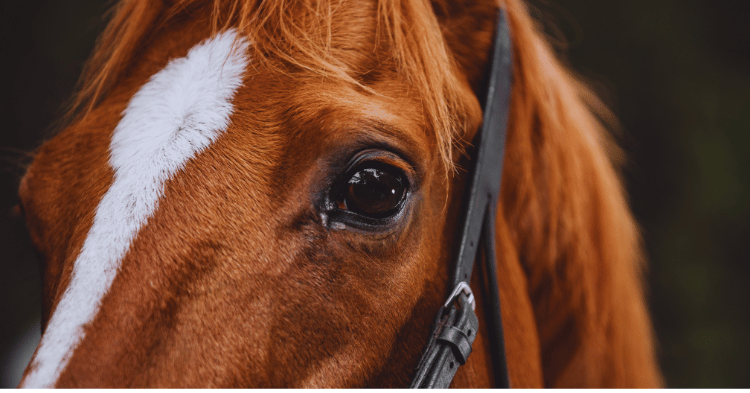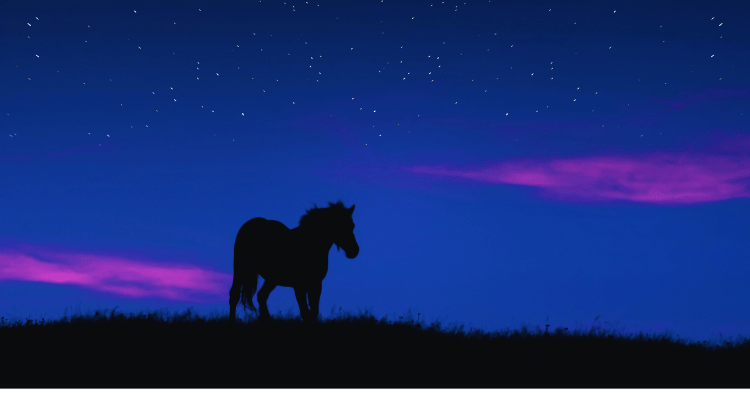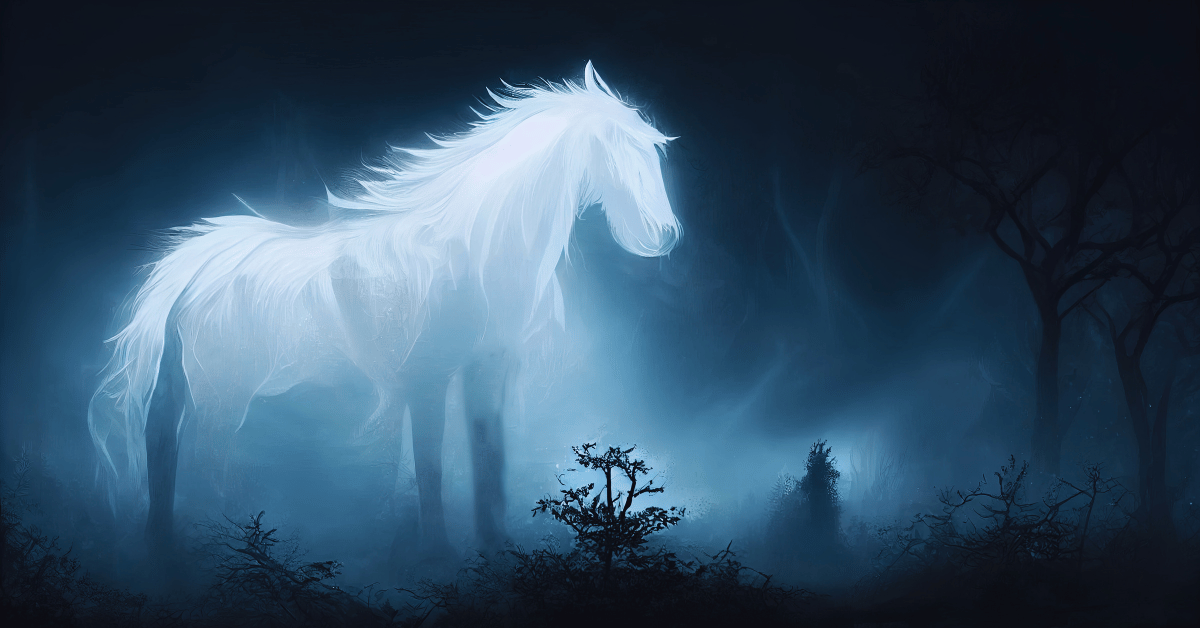Have you ever asked yourself, can horses see in the dark, and how do they manage to move so confidently at night? The answer lies in their remarkable eyes. Horses are naturally built for low-light environments, thanks to a special feature in their eyes called the tapetum lucidum. This reflective layer enhances their ability to gather light, making even the faintest moonlit paths visible.
While their night vision isn’t perfect, it’s far superior to ours. Horses can detect movement and shapes in near-darkness, a skill that kept their ancestors safe in the wild. However, sudden shifts between light and dark can momentarily throw them off.
Understanding their unique ability to see at night helps us care for them better, ensuring their surroundings are as comfortable and safe as possible, no matter the time of day.
The Vision of Horses

Understanding the vision of horses can help horse owners provide better care and ensure the safety of their equine companions. Horses have unique visual capabilities that enable them to navigate and thrive in various environments.
Understanding Horse Eyesight
Horses possess almost 360-degree vision due to the placement of their eyes on either side of the head. This evolutionary trait allows them to scan large areas for potential predators or dangers. However, this placement also results in blind spots directly behind and in front of their heads (Park City Equine Center).
| Vision Aspect | Human | Horse |
|---|---|---|
| Field of Vision | ~200 degrees | ~360 degrees |
| Blind Spots | Minimal | Front and Rear |
Factors Influencing Horse Vision
Several factors influence how horses see and adapt to their surroundings:
Rod and Cone Distribution: Horses have more rods than cones in their retinas, and significantly more rods than humans. This composition enhances their ability to see well in low-light conditions, contributing to their superior night vision.
Tapetum Lucidum: Horses have a tapetum lucidum, a reflective layer behind the retina that reflects light back into the retina. This structure further enhances their ability to see in the dark.
Light Adaptation: While horses see well in the dark, their eyes don’t adjust quickly when moving from dark to bright environments. It may take a few minutes for their vision to adapt to sudden changes in lighting.
Binocular Vision: The wide placement of a horse’s eyes results in less sharp binocular vision compared to humans. This makes it challenging for both eyes to see nearly identical images simultaneously. However, turning or lifting the head can enhance their binocular vision and eliminate blind spots.
For more insights on related topics such as can horse see color and can horses cry, explore our extensive collection of internal links. Understanding how your horse perceives its environment can foster a safer and more enriching relationship.
Horse Night Vision

Superior Night Vision Traits
Equines possess remarkable night vision capabilities, making them well-suited for activities like night rides. This is due to several unique traits in their eye anatomy. One of the key features contributing to their superior night vision is the high number of rods in their retinas as compared to cones. Rods are photoreceptors that function better in low light conditions. Horses have significantly more rods than humans, allowing them to see much better at dusk or in dimly lit areas.
Additionally, horses have a specialized layer of tissue called the tapetum lucidum, located behind the retina. This reflective tissue bounces light back through the retina, enhancing the amount of light that photoreceptors can process. This mechanism significantly boosts their night vision, allowing them to see nearly as well at night as they do during the day.
| Feature | Horses | Humans |
|---|---|---|
| Rods | More rods | Fewer rods |
| Tapetum Lucidum | Present | Absent |
| Night Vision | Superior | Inferior |
Adjusting to Light Changes
While horses excel in low light environments, they face challenges when moving between extreme lighting conditions. Equines do not adjust quickly to sudden changes from bright to dark areas or vice versa. This slow adaptation can temporarily impair their vision when switching environments rapidly (Park City Equine Center).
This characteristic is important for horse owners to consider during activities such as night riding or transitioning their horses from well-lit stalls to dark pastures. Gradual changes in lighting conditions can be beneficial to help the animals adjust their vision comfortably.
For further reading on equine vision, check our detailed articles on can horse see color and do horses sleep standing up.
The unique night vision traits of horses, enabled by specialized eye structures, make them exceptional in navigating low light conditions. Recognizing how their vision works can help horse owners better care for their animals and manage their activities effectively.
Binocular Vision
Challenges of Binocular Vision
Horses face unique challenges with binocular vision due to their eye placement. The positioning of their eyes on the sides of their heads provides them with a wide field of view, which is great for detecting predators, but it complicates their ability to see objects directly in front of them with both eyes simultaneously. Good binocular vision relies on both eyes seeing nearly identical images, but since a horse’s eyes are far apart, their binocular vision isn’t as sharp as that of humans (Park City Equine Center).
| Specification | Human | Horse |
|---|---|---|
| Field of View | 180° | 350° |
| Binocular Vision Overlap | 120° | 65° |
Enhancing Binocular Vision
Owners can help their horses enhance their binocular vision by understanding how horses adjust their head movements. Turning or lifting the horse’s head improves binocular vision, helping to eliminate blind spots and bring fuzzy images into focus. These movements allow the horse to align their eyes better and see more clearly.
Enhancing a horse’s vision may be particularly useful when riding them or when navigating unfamiliar terrain. Understanding these visual quirks can also help in training them and ensuring their safety.
For more information on how horses adapt to night vision or see in the dark, explore our article on can horse see in the dark.
Eye Anatomy of Horses
Eyesight Functionality
Horses have large eyes, both in absolute size and relative to their head size, which allows them to capture a significant amount of light. This contributes to their generally good vision. Their eyes are adapted to function well in various lighting conditions, enhancing their ability to navigate their environment.
The retina, the light-sensitive layer at the back of the eye, plays a crucial role in their vision. It contains a high number of photoreceptor cells:
- Rods (responsible for vision in low light) outnumber Cones (responsible for vision in bright light and for color perception).
A key feature of horse eyesight is the tapetum lucidum, a reflective layer behind the retina that bounces light back through the retina, giving rods and cones a second chance to absorb the light. This significantly improves night vision.
The most sensitive part of the horse’s retina is the visual streak, which is densely packed with photoreceptors. This area provides the sharpest images and converts visual information into electrical impulses, which are then transmitted to the brain via the optic nerve (Merck Vet Manual).
Eye Protection Mechanisms
Horses’ eyes are well-protected to prevent damage from external factors. They possess several anatomical features that contribute to this protection:
- Upper and Lower Eyelids: These can reflexively blink to protect the eye from debris and injury.
- Nictitating Membrane: Also known as the third eyelid, this additional layer provides extra protection against scratches or inflammation.
- Vascularization: The eyelids have a well-developed blood supply from various arteries, which aids in the rapid healing of the eyelids after any injury (ScienceDirect).
The motor and sensory innervation of the eyelids comes from several cranial nerves, ensuring that the eyelids function effectively to protect the eye:
- Motor Innervation: Provided mainly by cranial nerves CN III (oculomotor nerve) and CN VII (facial nerve).
- Sensory Innervation: Provided by cranial nerve CN V (ophthalmic branch of the trigeminal nerve).
The major muscles involved in the eyelid movements include:
- Orbicularis Oculi
- Levator Palpebrae Superioris
- Malaris Muscle
- Muller’s Muscle (ScienceDirect).
Understanding the eye anatomy of horses not only reveals their impressive visual abilities but also informs us about how to care for and protect their eyes. For more information on related topics, check out if can horse see color, or if dogs do horse sleep lying down, and how to help them deal with different visual challenges.

